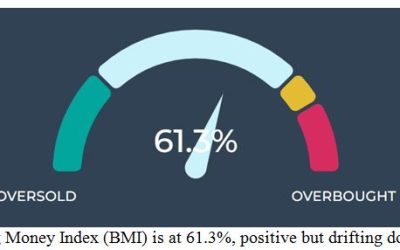by Louis Navellier
October 7, 2025
This shutdown may be good for investors. Our friends at Bespoke Investment Group (BIG) documented what happened during the last six federal government shutdowns. They found that the S&P 500 gained a substantial amount after three months (+6.6%), six-months (+12.1%) and 12-months (+19.7%). In other words, a federal government shutdown does not hinder the stock market and could even help. Since the private sector performs better than the government sector, productivity levels may actually increase.
A federal government shutdown was inevitable – and fully expected. According to Vice President J.D. Vance, the impasse between the two parties in Congress is over re-instating the healthcare benefits that were removed for illegal aliens, as well as for some U.S. citizens. In other words, some Democratic leaders want to reduce or nullify the key spending reductions of the Big Beautiful Bill, passed last July.
The Republican majority will not let this happen, so a federal government shutdown became inevitable.
During a federal government shutdown, many federal workers are typically furloughed. Economists estimate that up to 800,000 federal workers could be furloughed during this shutdown. In some cases, the Transportation Security Administration employees and air-traffic controllers will work without pay, according to plans published by the Homeland Security and Transportation departments, but in the last shutdown many TSA staffers called in sick or “absent” from work, so it will be interesting to see if air travel businesses (and other key commerce areas) are disrupted during a federal government shutdown.
Federal workers received their October 1st pay checks, and the next round of paychecks are due to be paid on October 16th, so it is widely perceived that there will be no budget deal until at least October 16th.
I should add that President Trump is threatening to fire many federal workers who fail to come to work, in an apparent attempt to scare Democratic Congressional leadership into ending the shutdown this week.
According to The Wall Street Journal, President Trump’s budget Chief Russell Vought “has been planning for this moment.” As the director of the White House Office of Management and Budget (OMB), Vought suspended $18-billion in funding for key New York City infrastructure projects, namely the Hudson River tunnel project and a subway extension. This infrastructure suspension was clearly meant to punish Senate Minority Leader Chuck Schumer and House Minority Leader Hakeem Jeffries.
Vought also canceled $8 billion in Energy Department funds for climate projects in more than a dozen Democratic-leaning states. I should also add that Vought issued a memo directing federal agencies to craft plans for widespread layoffs. In other words, White House OMB director Vought is playing hardball.
Despite this federal government shutdown, there is still plenty of evidence of resurging U.S. economic growth. For starters, consumer spending has been outpacing personal income, which implies that many consumers are incurring more debt to fund their spending spree. Also, this implies that the Fed needs to keep lowering rates to help the beleaguered housing industry and other interest rate sensitive sectors.
Last Wednesday, October 1st, the private company, ADP, reported that 32,000 private payroll jobs were lost in September, which was far below the economists’ consensus expectation of a 45,000 increase. Furthermore, ADP revised their August private payroll report to a loss of 3,000 jobs, down from a 54,000 gain previously reported. ADP also reported that 13,000 private payroll jobs were lost in June, so ADP has reported job losses for three of the past four months! This is the first time they’ve reported job losses since 2020, so the problems in the labor market are real. This should help the Fed decide to cut interest rates two more times this year, due to ongoing labor market problems as well as plunging Treasury yields.
In another privately provided statistic, the Institute of Supply Management (ISM) reported that its manufacturing index rose to 49.1 in September, up from 48.7 in August. Although any reading below 50 signals a contraction, the ISM manufacturing index is finally improving after contracting for seven straight months. The production component rose to 51 in September, up from 47.8 in August.
Another green shoot was the backlog of orders, which rose from 44.7 to 46.2 in September. However, only 5 of 16 sectors improved in September, as 11 sectors reported a contraction last month. Due to this overall weakness in U.S. manufacturing, the Fed clearly needs to cut its key interest rates further.
Then, on Friday, ISM announced that its non-manufacturing (service) index plunged to 50 in September, down sharply from 52 in August. Since any reading below 50 signals a contraction, the ISM service index is now teetering on a precarious brink, at 50. The main culprit for this decline was that the business activity component, which slipped to 49.9 in September, down sharply from 55 in August.
The ISM new orders component was 50.4 in September, falling sharply from 56.0 in August, and the ISM’s inventories component plunged to 47.8 in September, down from 53.2 in August. Overall, 10 of the 17 service sector industries that ISM surveyed reported an expansion but the abrupt slowdown in the service sector is a big warning flag, indicating that the Fed needs to continue to cut key interest rates.
Prepare for a Year-end Rally and a Strong 2026
Despite an anemic job market, the U.S. economy is currently running at a 3.8% annual pace, according to the Atlanta’s Fed’s latest GDPNow estimate, and I continue to believe that a 5% annual pace is likely in 2026, as all the on-shoring efforts will likely boost our overall GDP growth. The U.S. dollar is slowly getting its “mojo” back, and we are also importing deflation from China, so I am not anticipating inflation to perk up. This should allow the Fed to continue to further cut key interest rates. In other words, we are approaching “economic nirvana,” which is when the “velocity of money” perks up and prosperity rises.
This sets the stage for a strong year-end rally. I am expecting the S&P 500 to surge 8% in the fourth quarter and stage an impressive year-end rally. I should add that S&P 500 earnings are growing even faster than 8%, so my fourth quarter forecast may be conservative. For 2026, I am expecting the S&P 500 to rise 18% as strong corporate earnings persist and we get some more Fed key interest rate cuts.
The breadth and power of the overall stock market is expected to expand, as many stocks are far from overvalued. For instance, my average large-cap growth stock is trading at only 15 times forecasted earnings and, amazingly, my average small-to-mid-cap growth stock is trading at barely four times forecasted earnings, so I would tend to ignore all the bearish naysayers. Hang on and enjoy the ride!
This is a time to be fully invested, as I expect a strong year-end rally and an even more spectacular 2026!
The post 10-7-25: Shutdowns Are Generally Bullish for the Stock Market appeared first on Navellier.





